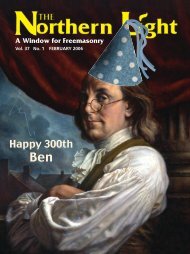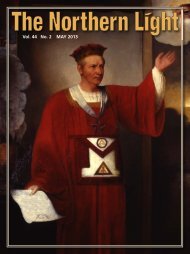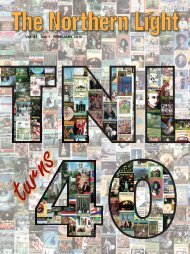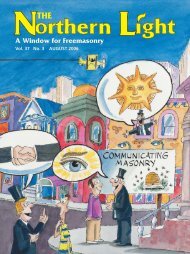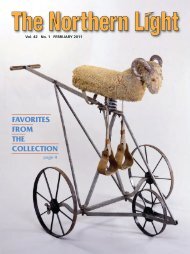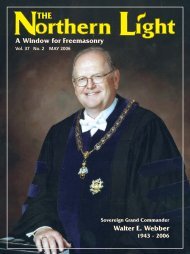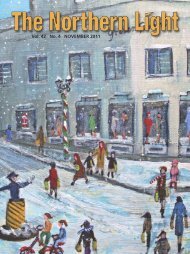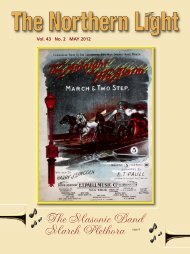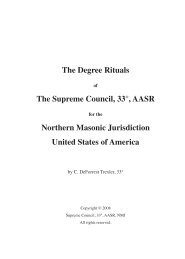May - Scottish Rite
May - Scottish Rite
May - Scottish Rite
Create successful ePaper yourself
Turn your PDF publications into a flip-book with our unique Google optimized e-Paper software.
Yet, just as recognized Freemasonry and its<br />
established Grand Lodges withstood the attacks<br />
of Anti-Masonic proponents, the 1899 letter<br />
quoted at the beginning of this article<br />
demonstrates that competing groups continued to<br />
exist as well. While Cerneau returned to France<br />
in 1827, just as American anti-Masonic fervor<br />
was mushrooming, his name continued to serve as<br />
an umbrella term for spurious and irregular<br />
Masonic groups. Although not directly connected<br />
to Cerneau’s Supreme Council in New York city<br />
in the 1810s and 1820s, the designation<br />
“Cerneauism” continued to be used by proponents<br />
and opponents into the 20th century and beyond.<br />
Cerneau’s Lasting Influence<br />
The existence — and persistence — of the<br />
Cerneau Supreme Council, and “Cerneauism” in<br />
general, has confounded members of the<br />
recognized Supreme Councils of the Northern<br />
Masonic and Southern Jurisdictions for centuries.<br />
As mentioned above, the official history of the<br />
Northern Masonic Jurisduction, published in<br />
1987 and written by former Sovereign Grand<br />
Commander George A. Newbury and Active<br />
Emeritus Member Louis L. Williams, takes a<br />
noticeable bias against Cerneau and his Brothers.<br />
These authors suggest that Cerneau started his<br />
group for unsavory reasons and was acting solely<br />
from hubris or some other ambition. Yet, more<br />
recent articles have started to suggest that<br />
Cerneau acted out of less malicious intent. In a<br />
1995 article published in Heredom, Michael R.<br />
Poll reviewed the work of Albert Pike in an<br />
attempt to resolve the question of the validity of<br />
Cerneau’s “right” to establish <strong>Scottish</strong> <strong>Rite</strong> bodies.<br />
He presented a convincing argument that<br />
Cerneau believed he had the authority to act and<br />
was doing so out of his own love for his<br />
fraternity.<br />
In a 1997 article in Heredom, Alain Bernheim<br />
transcribed a newly-found document originally<br />
presented to Cerneau by the Sovereign Grand<br />
Consistory of the United States of America in<br />
1827 when he returned to France. Presented by<br />
Cerneau’s own group, the document attests to his<br />
“zeal for the interests of the Order” and states<br />
that his Brothers “entertain the highest esteem &<br />
regard for his person, virtues and services.” While<br />
documents in Cerneau’s own hand remain<br />
unlocated, this document does provide a<br />
counterpoint to the negative impressions offered<br />
by the previous biographers of Cerneau and the<br />
men who ran the Supreme Councils of the<br />
Northern Masonic and Southern Jurisdictions in<br />
the 1810s and 1820s.<br />
While Cerneau himself sailed away, the<br />
Northern Masonic Jurisdiction experienced the<br />
“chaos” of spurious groups until the Union of<br />
1867, which once again settled questions of<br />
regularity and recognition by bringing multiple<br />
<strong>Scottish</strong> <strong>Rite</strong> groups together. Bideaud’s group<br />
continued to present itself as the authority after<br />
De La Motta confirmed it as lawful in 1813. As<br />
explained above, Cerneau’s group was taken over<br />
by Elias Hicks in 1827 and continued to meet<br />
until 1846 when it was dissolved and its funds<br />
were distributed to its members. But not all of<br />
Cerneau’s members followed Hicks. Henry C.<br />
Atwood started his own Supreme Council around<br />
the same time. In 1858, leadership of this group<br />
was bestowed on Edmund B. Hays.<br />
In 1860, Sovereign Grand Commander Edward<br />
Asa Raymond walked out of the recognized<br />
Supreme Council’s August meeting and declared<br />
it closed. Roundly understood to be suffering<br />
from a mental disorder, Raymond claimed<br />
“supreme and autocratic power” in December<br />
1860 and started another Supreme Council. This<br />
group existed until 1863 when it merged with the<br />
Atwood-Hays Council. Four years later an<br />
agreement was worked out regularizing the<br />
members of this Council and bringing them<br />
together with the recognized Supreme Council<br />
— the original Bideaud group that De La Motta<br />
accepted in 1813.<br />
The history of Joseph Cerneau and his patent<br />
continues to inspire debate and curiosity today,<br />
200 years later. This chapter of <strong>Scottish</strong> <strong>Rite</strong><br />
history touches on the fraternity’s origins while<br />
also demonstrating how cherished the bonds of<br />
Brotherhood were — provoking strong feelings<br />
and passionate emotions. Yet it may also offer<br />
insight that can assist us today with<br />
understanding some of the factors that make<br />
membership attractive.<br />
Aimee E. Newell, Ph.D., is Director of Collections<br />
at the <strong>Scottish</strong> <strong>Rite</strong> Masonic Museum and Library.<br />
To discuss a donation for the collection, or to ask a<br />
question, email anewell@monh.org or call<br />
NL<br />
781-457-4144.<br />
The Northern Light / <strong>May</strong> 2010 7




